 Website:
Rotor Clip Company
Website:
Rotor Clip Company
Catalog excerpts

... ujjiJ jjJO.S
Open the catalog to page 1
What Is a Retaining Ring? Traditional method of fastening. Cost-saving method offered by Rotor Clip. The traditional method for fastening components and assemblies in housings and on shafts usually involves some type of shaft/housing preparation and multiple components to accomplish the fastening task. Note the example above. You could hold the shaft to the brace by drilling a hole through it, installing a washer and fastening the system with a cotter pin. It may seem simple, but in today’s cost-cutting, global environment, greater savings are available than offered by this traditional...
Open the catalog to page 3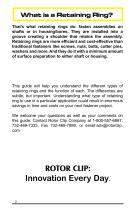
What is a Retaining Ring? That’s what retaining rings do: fasten assemblies on shafts or in housing/bores. They are installed into a groove creating a shoulder that retains the assembly. Retaining rings are more efficient and cost-effective than traditional fasteners like screws, nuts, bolts, cotter pins, washers and more. And they do it with a minimum amount of surface preparation to either shaft or housing. This guide will help you understand the different types of retaining rings and the function of each. The differences are subtle, but important. Understanding what type of retaining...
Open the catalog to page 4
Axial Retaining Rings Axial RotorClips® retain assemblies on shafts and in housings and bores. Inch: HO, SH, HOI, SHI, BHO, VHO, BSH, VSH, SHR, SHM; DIN Metric: DHO, DSH, DHI, DHT, DSI, DST, DHR, DSR; ANSI Metric: MHO, MSH, MSR 1. Internal housing/external shaft retaining rings. 2. Feature lugs and lug holes used to install/remove the rings (except for the SHM ring). 3. Make almost complete circular contact with the groove enabling them to withstand significant thrust loadings. 4. Made to World Standards —Inch, DIN (Metric), ANSI Metric, JIS. 5. Installed in an axial (horizontal) direction...
Open the catalog to page 5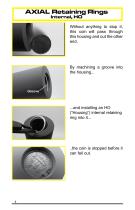
AXIAL Retaining Rings Internal, HO Without anything to stop it, this coin will pass through this housing and out the other end. By machining a groove into the housing... ...and installing an HO (“Housing”) internal retaining ring into it... ..the coin is stopped before it can fall ou
Open the catalog to page 6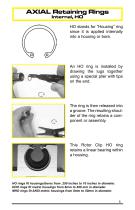
AXIAL Retaining Rings Internal, HO HO stands for “Housing” ring since it is applied internally into a housing or bore. An HO ring is installed by drawing the lugs together using a special plier with tips on the end. The ring is then released into a groove. The resulting shoulder of the ring retains a component or assembly. This Rotor Clip HO ring retains a linear bearing within a housing. HO rings fit housings/bores from .250 inches to 10 inches in diameter. DHO rings fit metric housings from 8mm to 400 mm in diameter. MHO rings fit ANSI metric housings from 8mm to 50mm in diameter
Open the catalog to page 7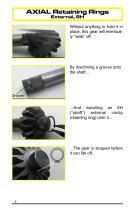
AXIAL Retaining Rings External, SH Without anything to hold it in place, this gear will eventually “walk” off. By machining a groove onto the shaft... ...And installing an SH (“shaft”) external circlip (retaining ring) onto it... ...The gear is stopped before it can fall
Open the catalog to page 8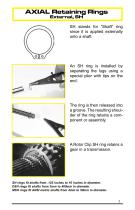
AXIAL Retaining Rings External, SH SH stands for “Shaft” ring since it is applied externally onto a shaft. An SH ring is installed by separating the lugs using a special plier with tips on the end. The ring is then released into a groove. The resulting shoulder of the ring retains a component or assembly. A Rotor Clip SH ring retains a gear in a transmission. SH rings fit shafts from .125 inches to 10 inches in diameter. DSH rings fit shafts from 3mm to 400mm in diameter. MSH rings fit ANSI metric shafts from 4mm to 50mm in diameter
Open the catalog to page 9
AXIAL Retaining Rings Inverted, Internal, HOI HOI - WHEN CLEARANCE IS A PROBLEM Sometimes the lugs of the standard HO can interfere with the functioning of an application. Consider the example below: Let’s take a look at our housing once again. This time, we have an application that requires an E ring to retain a component on this transmission spool valve and an HO ring to retain another component. As you can see, the lugs of the HO interfere with the E ring. Time for a different fastener? Not at all. The lugs of the rings can be reversed to form another internal ring called an HOI (the “I”...
Open the catalog to page 10
AXIAL Retaining Rings Inverted, External, SHI SHI - WHEN CLEARANCE IS A PROBLEM Similarly, the lugs of the standard SH ring can interfere with the funcioning of an application. Consider the example below: This SH ring is holding in place the threaded portion of this doorknob. But this piece can not be threaded into the knob’s base because the lugs are in the way. By using an SHI the lugs are reversed and do not interfere with the threads. SHI rings fit shafts from .500 inches to 3.938 inches in diameter. DSI rings fit shafts from 12 mm to 100mm in diameter.
Open the catalog to page 11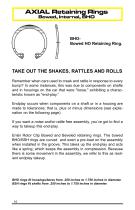
AXIAL Retaining Rings Bowed, Internal, BHO BHOBowed HO Retaining Ring. TAKE OUT THE SHAKES, RATTLES AND ROLLS Remember when cars used to creak and rattle in response to every bump? In some instances, this was due to components on shafts and in housings on the car that were "loose," exhibiting a characteristic known as "end-play.” Endplay occurs when components on a shaft or in a housing are made to tolerances; that is, plus or minus dimensions (see explanation on the following page). If you want a noise and/or rattle free assembly, you’ve got to find a way to takeup this end-play. Enter...
Open the catalog to page 12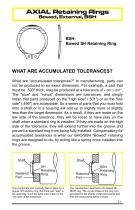
AXIAL Retaining Rings Bowed, External, BSH BSHBowed SH Retaining Ring. WHAT ARE ACCUMULATED TOLERANCES? What are "accumulated tolerances?" In manufacturing, parts can not be produced to an exact dimension. For example, a part that must be .500" thick, may be produced at a tolerance of +.001"/-.001". The "plus" and “minus" dimensions are tolerances, and simply mean that parts produced on the "high side" (.501") or on the "low side" (.499") are acceptable. So a series of parts that you must hold onto a shaft or in a housing will add up to slightly more or slightly less than the target...
Open the catalog to page 13All Rotor Clip Company catalogs and technical brochures
-
Company Overview
44 Pages
-
Wave Spring Catalog
44 Pages
-
Distribution Brochure
16 Pages
-
Oil & Gas Industry Brochure
8 Pages
-
Medical Industry Brochure
8 Pages
-
Aerospace Industry Brochure
12 Pages
-
Automotive Industry Brochure
12 Pages
-
Product Catalog
276 Pages
-
THE WORLD' QUALITY SOURCE
12 Pages
-
Rotor Clip Oil & Gas
8 Pages
-
Rotor Clip Wind Power
4 Pages
-
Rotor Clip Company Overview
44 Pages
-
Wave Springs
8 Pages
Archived catalogs
-
CTB
1 Pages
-
HO
6 Pages
-
CFS
3 Pages
-
DE
1 Pages
-
DSH
2 Pages
-
DHI
2 Pages
-
BSH
2 Pages
-
E
2 Pages
-
SH
6 Pages
-
MCG
2 Pages
-
DCR
2 Pages
-
MKA
2 Pages
-
MKG
2 Pages
-
MKR series
2 Pages
-
Retaining Ring Plier Kits
1 Pages
-
Retaining Ring Kits
1 Pages
-
DSI
2 Pages
-
DSH
8 Pages
-
DHR
1 Pages
-
DHT
2 Pages
-
Applicators and dispensers
3 Pages
-
Hose clamp tools pneumatic
1 Pages
-
HC Hose Clamps
1 Pages
-
KMS Shims
1 Pages
-
Wave springs
12 Pages
-
PO Shaft Rings
2 Pages
-
LC Shaft Rings
2 Pages
-
VHS Shaft Rings
4 Pages
-
BSH Shaft Rings
2 Pages
-
SHM Shaft Rings
2 Pages
-
SHI Shaft Rings
2 Pages
-
SHR Shaft Rings
2 Pages
-
SH Shaft Rings
6 Pages
-
VHO Shaft Rings
6 Pages
-
BHO Shaft Rings
2 Pages
-
HOI Shaft Rings
2 Pages
-
HO Shaft Rings
6 Pages
-
Bearing Chart
3 Pages




























































